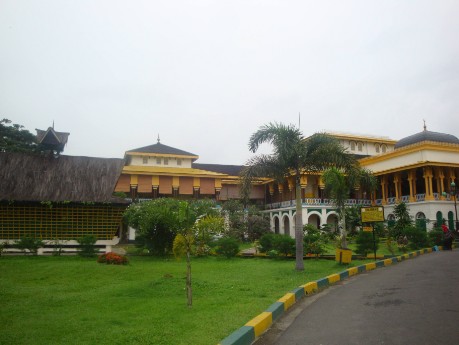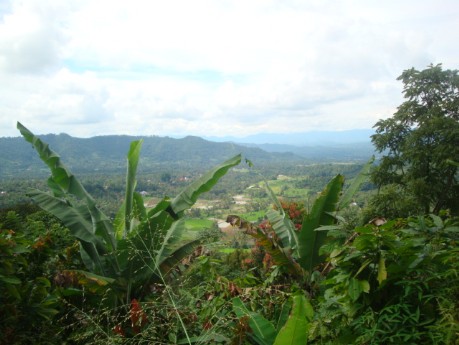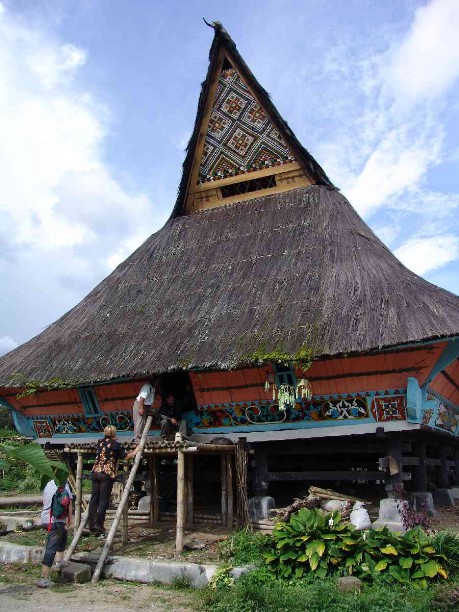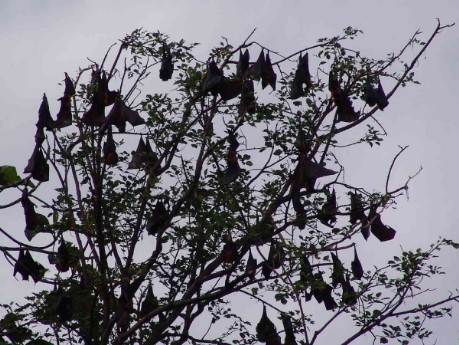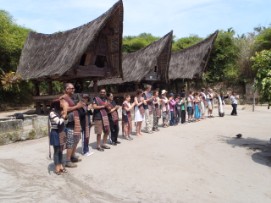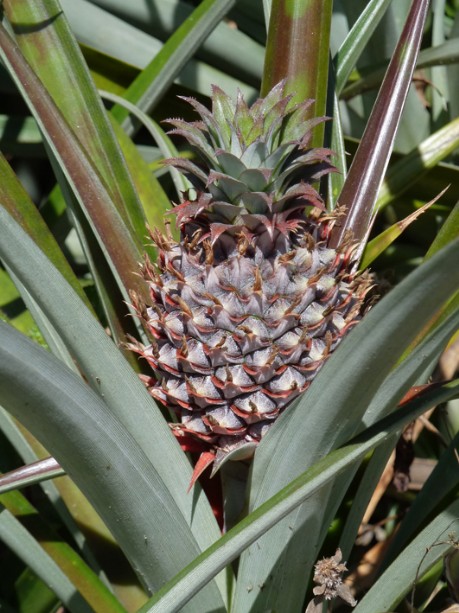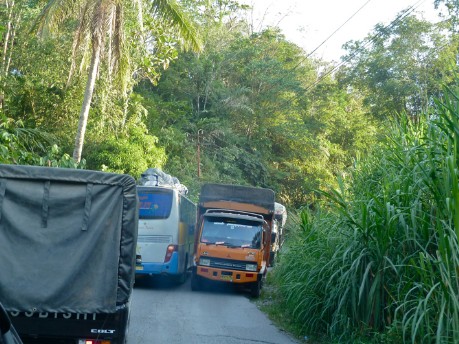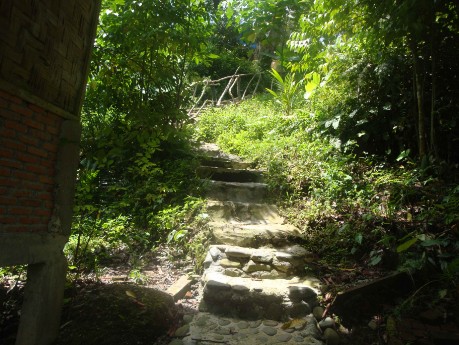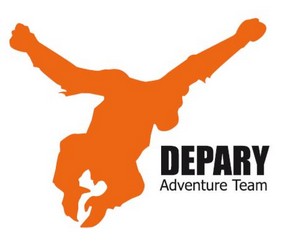Sumatra
Informations
The northern part of Sumatera,
i.e. the provinces of Aceh (Nanggroe Aceh Darussalam) and North Sumatra (Sumatera Utara) lies just above the equator. To the east is the Malacca Straits and in the west the Indian Ocean. There are both active and dormant volcanoes. Many of them well over 2.000m above sea level. The east coast consists mainly of lowland with mangrove swamps next to the sea. Several big rivers carry down sediments to this area and over the centuries the coastline has slowly moved eastward. The west coast has a steeper coast and many great sand beaches. Off the coast are the big islands of Simeulue and Nias and in between the archipelago of Pulau Banyak. A very deep trench in the sea west of these islands gives excellent conditions for surfing in many places. This part of Sumatra is unique with its scenery and grand nature.
The climate is tropical, but due to its many highlands, temperatures can be lower than one expects. Temperatures are approximately between 22-30 degrees Celsius. The rainfall differs from area to area, but averages 1.000-4.000mm per year. The relative humidity is 70-90% in lowlands. The year can be divided in two major seasons, dry season from February to August and wet season from September to January. However, the difference between seasons is not as big as in other parts of Indonesia. The change of season is also normally extra wet. The dry season is of course the best time for mountain climbing, to visit nature parks and for the visibility of animals, etc.
North Sumatra
Home to a diverse array of cultures and a fascinating kaleidescope of Indonesian life, the region of North Sumatra has many wonders to explore. North Sumatra’s specacular natural beauty spreads from the magnificent Lake Toba, the biggest lake in Southeast Asia, to the jungle of Bukit Lawang which organgutans make their home. The natural and cultural wonders here make this is a region to come and have a true adventure.
The landscape here has been shaped by thousands of years of volcanic activity. From the incredible Lake Toba which was formed around 75,000 years ago in one of the most fierce volcanic eruptions ever known to the still smouldering Mt Sibayak, volcanoes dominate the landscape everywhere.
North Sumatra is home to rare and exotic wildlife. Discover exceptional and unique species like the orangutans, the white-handed gibbon, and 17 types of bird. For nature lovers, the extraordinary ecosystems which exist here are well worth a visit.
The largest city in this region, Medan, is a thriving metropolis, and one of the biggest cities in Indonesia. The population of the city is diverse, representing virtually every ethnicity in Indonesia. As one of the most important economic hubs in the country, Medan is also a place to do business with a number of oil and plantation export companies operating here and in the surrounding region.
Whether you’re after a jungle adventure, a relaxing holiday in pristine natural surrounds or an authentic experience of native Batak culture, this is a region which has it all.
History
North Sumatra is a treasure chest of culture and tradition waiting to be explored, with ancient graves of Batak kings, unique dances and ceremonies plus beautiful arts and crafts.
Entry
The main airport in this region is Polonia Airport, Medan. There are daily flights between Medan and most major cities in Indonesia.
International flights also go directly to Medan.
Belawan seaport is the sea link to Penang, Malaysia.
With a population of around 12 million people, the people of this region can be divided into five main ethnic groups and languages: The coastal Malays, living along the Malaka Straits, the Bataks, the Angkola or Mandailing of the southern Tapanuli, and the Nias Islanders off the western coast of the province. These groups each have their own dialects, religious beliefs, arts, custom and cultures. Several other ethnic groups also live in Medan and other towns of North Sumatra, the largest of these being Chinese and Indian.
In the capital city of Medan there are ethnic tribes from all over Sumatra and Indonesia who’ve come to the city to do business. The city is also home to a sizeable Chinese and Indian population.
Living in a spectacularly beautiful part of North Sumatra around Lake Toba, the Batak people are divided into six cultures, each with their own language, ceremonies and traditions. Although geographically isolated, the Bataks have a history of regular contact with the outside world. Trade between the highlands and other regions saw the exchange of goods such as salt, cloth and iron which were imported into the region for gold, rice and cassia (a type of cinnamon).
The first Europeans to venture into Batak territory were missionaries, who began to explore the remote inland region in the late 18th century. Missionaries would send reports home of a fierce and defiant local society with frequent mentions of cannibalism. As early as the 9th century, an Arab text mentions that Sumatra’s inhabitants eat human flesh. Today anthropologists believe this was a rare form of capital punishment that may have seemed more common than it actually was as many Batak kept the bones of their tribal ancestors which may have been mistaken by outsiders as grisly trophies.
Traditional Batak beliefs center on a spiritual understanding that the universe is divided into three, the upper world where the God’s reside, the middle world which belongs to humans and the lower world which is home to ghosts and demons.
Medical care in Batak culture focuses on the condition of the soul. It’s believed that sickness is caused when the soul flees the body in which case a shaman (traditional healer) is needed to come and help call the wandering soul back to the patient.
In the Batak highlands you will see traditional houses with distinctive high pointy roofs line the landscape. These houses are on stilts so that the family’s animals such as pig and buffalo can live underneath.
In North Sumatra you’ll find a treasure chest of cultural and heritage attractions waiting to be explored. Soak up the culture here with a visit to the ancient graves of Batak kings, a performance of traditional dance or look at the locally produced beautiful arts and crafts.
Cuisine
Sumatra food is famous for being spicy and cuisine from North Sumatra is no different.
When you’re in town, try local dishes like Chicken Rice, Medan Kweetiaow and others. Most of the dishes here are influenced by Malay, Chinese and Indian culture.
For those who want to embrace exotic cuisine, North Sumatra offers unusual dishes including with ingredients like dog, congealed blood and pig. You can easily find those in certain restaurants, just ask around.
While in Berastagi, make sure to visit traditional markets and sample the exotic fruits. A glass of marquisa syrup will quench your thirst, and it can be consumed hot or cold. This is also a perfect souvenir for your loved ones.
Tourism Office
Jl. Jend. A. Yani No.107, Medan. 20111
Phone. (061) 4538101, 4520559, 4524908 Fax. (061) 4528436
ABOUT LAKE TOBA
The world famous crater lake of Danau (Lake) Toba is the third biggest tourist destination of Indonesia. The island in the huge lake, Pulau Samosir, attracts many tourists. Lake Toba is the largest lake in Southeast Asia, once created by an enormous eruption less than 100.000 years ago. The eruption was approximately 8.000 times more powerful than the eruption of Mount St. Helen in 1981. Ashes in the stratosphere circled around the earth for years and changed the climate. As things began to settle another volcanic eruption happened about 25.000 years later and built up a secondary volcano inside the caldera. The cone of that volcano collapsed and formed the island Samosir while the crater of the first eruption filled with water, what to become Danau Toba.
The lake covers approximately 1.265 square km excluding Samosir and is 90 km long. The depth is in on average 450m and up to 900m in some places. The lake is situated at an altitude of 906 m above sea level. The steep coastline interspersed with small valleys creates fantastic scenery and isolated areas. The deepest end and the highest mountains are at its northeastern end. The Dutchman H.N. van der Tuuk was the first European who saw and reported about the lake, in 1847.
There are of course legends on how Lake Toba was formed. The following is a Batak Toba legend: Once upon a time there was a man living in the area of the present day Danau Toba. No one knew when or from where he came. He lived in a simple hut in a farming area. He had a garden and did some fishing. One day he caught a big fish in his trap. It was the biggest catch ever in his life. Back home the fish turned into a beautiful princess decorated with jewels. He fell in love with her and proposed to her. She nodded romantically, however, the princess had one condition. The man had to promise never to tell anyone that she had been a fish. If he would, there would be a disaster. They married and got a daughter and lived happily. The daughter always brought lunch to her father out in the fields. The girl was however very greedy and one day she ate all her father's lunch. Her father got angry and scolded: "You damned daughter of a fish!" The princess started to
cry when she heard what her husband had said. She told her daughter to go to the hills, as there would be a disaster. When the daughter had left for safety the princess prayed. Soon there was an earthquake, rain started to fall and springs appeared everywhere. The whole area got flooded and became Lake Toba. The princess turned into a fish again and the father became the island of Samosir.
The traditional Batak canoe, the solu, was 10-15m long. All had the same width. The canoes of the chiefs were decorated with carvings. The captain, the Chief, sat in front and gave orders. The solu had its own spirit and when a new canoe was built offerings were made for both the canoe spirit and to Boru Saniang Naga, the Goddess of the water. Bataks feared her as disasters could easily happen when she was angry.
Three years ago Lake Toba reached its lowest water level ever, which caused problems, for example for tourism. The level had then fallen several meters and the lake was a rather depressing sight for people who had seen it before. The reasons for the falling water level were deforestation and over consumption of water by a pulp factory and a hydroelectric power plant near Porsea. The companies consumed more water than the capacity of Lake Toba allowed. After strong and sometimes violent protests from the local communities, the pulp factory, Indorayon, was closed down. The protests were based on many different interests and concerns, amongst others of course environmental concern. The water level is however, also controlled by the big dams of PT Inalum. Since the closure of Indorayon, the water level in Lake Toba has reached its normal level and the lake has regained its original beauty.
THE ETHNIC GROUP KARO
The Karo Regency covers an area of more than 2.000 square kilometers (or 3% of North Sumatra) on an average altitude of 700-1.400 m above sea level. Average temperature is 16-27 degrees Celsius, and average rainfall 1.000-4.000 mm per year. The active volcanoes Gunung Sibayak (2.000m) and Gunung Sinabung (2.400m) are visible from most points in the Karo regency. When looking out over the Karo landscape, at the first glance, it often looks rather flat. However, if one moves around along small roads, one soon realizes that the landscape is varied with many small and deep valleys making the traveling very nice and giving unexpected views.
The population of the Karo regency is app. 300.000. The regency capitol is Kabanjahe even though Berastagi is more known amongst foreigners. App. 75% of the population is farmers. Tourism, both international and domestic also plays an important role in the economy, however now less important than before. The fertile land of Karo has made the area known for fruits, vegetables, and flowers. The Berastagi Marquisa (passion fruit) is well known throughout Indonesia and is a local delicacy. The big cash crops are oranges (mandarines), cabbage, and corn. The Karo people are known to be hard workers.
The Karo people are normally described as one of six sub-groups of the Batak people. However, Karo scholars claim that they form their own ethnic group, the Karo. Others say that the Karo are closely related to the Melayu. The Karo people have, like the other Batak peoples, a strict clan system. There are five so-called original clans (marga): Karo-Karo with 20 sub-clans, Sembiring with 18 sub-clans, Tarigan with 14 sub-clans, Perangin-Angin with 18 sub-clans, and Ginting with 16 sub-clans. When people of other ethnic background move to Karo they are given a Karo clan name and, in such a way, are faster assimilated. For example a Sihotang from Toba becomes a Karo-Karo Sitepu. The clan system is today not as strict as it once was.
The Karo people embrace several religions and they live peacefully together. Even the smallest village has normally both Christians and Muslims living next to each other, in some cases even in the same longhouse. There are still people of older local religions (called Pemena), however they are few and less visible nowadays. Half of the Karo people are Protestant, 18% are Catholics, and 28 % Muslims. Other religions cover 2% of the population, including a few Hindus. Karo became Christians or Muslims during the last century. The first Christian conversions took place as late as in the 1930's. Hinduism was much more influential in Karo than in other Batak areas, especially in the Sembiring clan. Biring is a Karo word meaning “black”. It is almost impossible to find any religious fanatics in Karo.
Traditional Karo ceremonies can be very interesting. Many are disappearing, but some still exist and take place in certain villages.
* Pesta Tahun is a yearly cermony which usually is celebrated after the harvest. The time for Pesta Tahun differs from village to village. Village elders choose the appropriate day, with the help of the Karo calendar. Traditional dancing is performed and traditional Karo food is served. The dancing normally starts in the evening. The young people normally party until morning.
* Erpangir Kulau is a bathing ceremony that cures us from evil curses. Offerings are presented to God for his blessings. It can for take place, for example, at weddings and baptism.
* The ceremony Perumah Begu still survives amongst Animists. A shaman communicates with spirits of ancestors by letting them possess his body. In this way information about the future can be obtained and longing for the ancestors can be conveyed.
* Other ceremonies to look out for are: Erdemu Bayu is a wedding ceremony involving many agents between the groom and the bride. Mengket Rumah is a housewarming party and Cawir Metua is a ceremony for people who have passed away at old age. Ngampeken Tulan-tulan is the Karonese version of the Batak Toba Manongkal Holi where the remains of important ancestors are exhumed and given a better grave. It is a way of improving the status of the ancestor. Gundala-gundala is a Karonese dance where the performers use masks. Tarian Lima Serangkai is a dance by five couples representing the five original Karo clans. If you want to take part in a Karo ceremony it is recommended to dress up a bit. Use long trousers and be clean. The locals will appreciate it.
Traditional Karo houses are still in use in many. However, nowadays most people find the traditional house too cramped and old-fashioned. In general, this is a problem as many houses are left to fall apart. It is expensive to repair these kinds of houses and not many people know how to do it any longer. The government doesn't have enough funds either to help the locals to save their cultural heritage. A traditional house falls apart fast if no one lives in it. The smoke from the kitchen keeps destructive insects away.
A traditional Karo house is built approximately 2m above the ground and is resting on 16 pillars. Four, six, eight, or twelve families used to occupy one house. Two families shared one open fire. The inside is one open area, but alcoves were often available for intimate moments of married couples. Animals and firewood were kept underneath the house. The Karo house has two doors. One leads to the west and one to the east. In front of each door is a verandah of bamboo, called ture. Here, women were weaving, making pandanus mats or other handicrafts. Women gave birth sitting on the steps leading up to the doorway. The roof of the house was made of ijuk (fiber from the sugar palm), resting on bamboo. The roof has two triangular gavels made of bamboo ornament called ayo-ayo. On top is a buffalo head looking down. No nails were used to construct the house.
Besides houses for living there are also other kinds of houses. The jambur is a roofed platform were people who broke the king’s law or village traditions were punished. It was also used for discussions and so called musyawarah (an Indonesian tradition of solving problems by talking until full agreement is reached). The geriten is a building that was used to keep the sculls of important families. The lesung was used for milling rice. The sapo was used for storing rice. The rumah lajang was the building where unmarried men slept.
To build a house, from the moment the trees were cut until moving in, involves seven different traditional ceremonies. The first ceremony is for choosing trees to cut down. The second to the fifth ceremonies concern different stages of the building process. The sixth ceremony is for placing the buffalo heads and the last is when moving in, the housewarming party. It was important to choose good timber, as there were no forms of wood preservation. It took 40 persons about 12 month to build a 10m long and 8m wide house. Approximately 100 trees were normally needed.
Karo Food: Tasak Telu is a chicken boiled in a special way and given to a pregnant woman and her husband by the parents after app. 4-5 months pregnancy. They have to eat it from the same plate. Children also give it to their parents who recently have recovered from sickness. They all eat the chicken together. Tasak Telu can also be given to children who have successfully finished their final exam. A specialty often served at traditional ceremonies is a kind of cake made of grass taken from the first stomach of the cow (rumen), or Pagit-pagit in Karonese. The grass from the cow is squeezed and then cooked together with leaves of the sweet potato. It is considered very delicious. Another cake for special events is Kueh Cimpa, which is made of rice flour, coconut, and palm sugar.
If you prefer more "normal” food try the fish dishes "Ikan Mas Arsik" (Gold fish curry), "Ikan Mas Panggang" (grilled Gold fish) or "Ikan Nila Panggang" (grilled Nila fish). The Karonese are also known for their good BBQ-pork. There are many restaurants specialized in it. A sign saying “B2” indicates that they serve pork. "B1" indicates that they serve dog meat. Try the local alcoholiv beverage "Tuak". It is the fermented fruit jiuce from the sugar palm. It has to be fresh.
Oukup is a kind of traditional Karonese steam bath. A mix of spices, including orange peel is boiled. Traditionally the person covered himself with a blanket and placed a bucket with the steaming hot water beneath. Today it has been modernized and the person sits in a small chamber and the steam enters via a pipe. This modern form has become very popular the last few years, especially in Medan where hundreds of Oukup establishments have popped up. However, many of these establishments are like many massage parlors, only a cover-up for more amoral activities. When visiting an oukup-establishment, which is recommended, you will notice what kind of place it is when you enter. The steam bath is considered to be good against flu, headache and sleeping problems.
West Sumatra
Much of its highland is formed by the Bukit Barisan Mountain range; virgin jungles inhabited by elephants, tigers, leopards and rhinos. Minang people have spicy-hot dishes and ancient matriarchal customs. The women own property and the men leave home to seek their fame and fortune. Traveling is considered a mark of success, Padang restaurants are found in all major towns across the nation. The people are hospitable and eloquent. They primarily speak bahasa Minang, with poetic style of speech.
Entry
Getting There : Padang's Tabing Airport is the main gateway to West Sumatra and is serviced by Merpati Nusantara Airlines. PELNI's ship "Kerinci" sails every two weeks for Jakarta from Teluk Bayur Harbour. Smaller vessels from Muara Harbour sail to small towns along the entire west coast of Sumtra. Regular bus services run between Padang, Bukittinggi and other major cities of Sumatra, as well as via the trans-Sumatra Highway to Jakarta. West Sumatra days are filled with colorful ceremonies and festivals. Legend of the Minangkabau is descendants of the youngest son of Alexander the Great, King Maharjo Dirajo. During the early 19th century, the area was disrupted by wars between the followers of the traditional Islam or Padris, and those adhering to the traditional law (Adat) of the Minangkabau.
South Sumatra
One of the greatest kingdoms in Indonesian history, the Buddhist Empire of Sriwijaya prospered along the banks of Musi River in South Sumatra over a thousand years ago. Located on the southern-most rim of the South China Sea, close to the one of the world’s busiest shipping lanes linking the Far East with Europe, the Region’s historical background is rich and colorful. Sriwijaya kingdom practiced a bustling and productive trade with ancient China during its golden years.
Stretching from the foothills of the mighty Bukit Barisan mountain range, this province is relatively flat but very fertile, with numerous rivers cutting across the landscape and meandering their ways to the sea. Coffee and tea plantations are scattered across the province, but South Sumatra’s enormous wealth comes from oil, natural gas, coal, tin and quartz reserves.
History
In 672, the Chinese scholar, I Tsing, recorded that a thousand monks and scholars could be seen translating and studying Sanskrit in Palembang, the capital of South Sumatra. This shows that more than a thousand years ago, Palembang under the reign of Sriwijaya kingdom was prosperous and rich in culture. Many relics and remnants of this mighty kingdom can still be found in this area.
Entry
Getting There : Many domestic Airlines serve to Palembang. Garuda Indonesia airlines serves flight from Osaka, Tokyo, Jeddah, Riyadh, Guangzhou, Shanghai, Singapore and Perth as well as major cities in Indonesia to Palembang. Air Conditioned busses from Java and Sumatra are also available.
People & Culture
Songket, made of silk combined with gold thread, will fascinate traditional cloth collectors because of its rich designs and elegance. It’s also a great keepsake to buy, although the price of this first grade hand-woven songket might be quite expensive.
Palembang is also famous for its wood carving motifs, influenced by Chinese and Buddhist designs. The carvings are dominated by decorations in the form of jasmine flower and lotus seen in the furniture and lacquers
Bengkulu
The capital of Bengkulu Province is the coastal city formerly known as Bencoolen. It was the site of Sir Stamford Raffles first entrry into Indonesia and there are still remains of British influence in the area. The primary crops of the area are pepper, coffee, nutmeg and sugar cane. The most fascinating nature charms are the exotic Rafflesia Arnoldi. Dubbed the largest flower in the world, it's actually a parasite luring insects into it by emitting rotten odor.
History
Apparently not much is known about Bengkulu's past, save from the fact that it used to consist of small kingdoms. It developed its own script called ka-ga-nga. Majapahit seemed to take Bengkulu into its wings but after this mighty kingdom fell, Bengkulu was left to its own devices until the British came and take over. The British wanted to monopolize the pepper, grown abundant here, but constant attacks of malaria and boredom made them think that Bencoolen, like they preferred to call it, was not that promising.
When Sir Thomas Stamford Raffles arrived in 1818 as the British ruler, he somehow managed to turn Bengkulu into a success. He made the best of pepper trade, and he also make them grow coffee, nutmeg and sugar cane here.
Bengkulu is also well-known as the exile place of Indonesia's first president, Sukarno, in 1938-1941.
Bengkulu Province is easily accessible by land, air and sea transportation. You can catch regular buses directly from Medan, Padang or Jakarta. Flight arrives there times a day. Domestic ships from Jakarta, Padang and Medan stop by in Baai Harbor, Bengkulu.
Most inhabitants here are Malay and the culture and habits are somewhat similar to neighboring provinces.
Poncan Island-Sibolga
Sibolga is a city and a port on the west coast of North Sumatra province, in Indonesia. It is located on the western side of North Sumatra, facing the Indian Ocean and is a transit harbour to Nias island. It was hard hit during the 2004 Indian Ocean Earthquake.Poncan Ketek Island (Small Poncan Island) in Sibolga Bay was once the location of a fort. British, Dutch, French and American traders passed through here. It is thought Stamford Raffles passed through before he moved to Bengkulu in south Sumatra. From Bengkulu Raffles, after relinquishing the Port to the Dutch, established the trade port that became Singapore.Ferries from here service the outlying islands to the west, Simeulue and Nias, as well as the rest of Indonesia. Sibolga has attractions of its own in terms of its historical background, beaches and coral gardens in a sea dotted with islands. Sibolga is a step off point for trade and passenger boats to Nias Island.
Sikuai Island
Sikuai is an island in the sub-district of Bungus Teluk Kabung, City of Padang, West Sumatra Province,
An easy flight into Padang, capital of West Sumatra Maningkabau, with low cost airlines out of Kuala Lumpu, Jakarta and Singapore, Sikuai Island Resort is a beautiful tropical island off the coast.Part of the Bugus Island chain, formed millions of years ago, this white pearl of an island, is the first in the chain of this untouched archipelago.A scenic 30 minute drive south of the airport, and a half an hour speed ferry ride to the island, Sikuai is perfectly situated for a weekend getaway from the cityand it is sophisticated island which shine like a pearl in a beautiful white sand beach, while exotic wave may exited those who craves for splashing experience.
FLORA AND FAUNA
The Flora and Fauna in Sumatra is similar to the Asian mainland, but Sumatra has still vast rainforests and much wildlife. Until the end of the 19th century the almost only thing you could find on the island was forest. Nowadays only 30% of Sumatra's former jungle remains. This doesn't mean that Sumatra has changed into a deforested island. There are vast areas of untouched lowland rainforest and sub-mountainous and mountain forests. Alpine vegetation occurs at the higher altitudes. Extinction and destruction goes on also in Indonesia, but it started later than in other countries. There is still time to both see and save it. The island of Sumatra can brag with several hundreds of mammals, almost 200 reptiles, over 60 amphibians, almost 300 fish species, and more than 450 bird species. Of all these, 9 mammals, 30 fish species, and 19 bird species are endemic.
Even though North Sumatra is one of the more populous provinces of Sumatra, there is still enough of wilderness for anyone. There is the huge national park of Leuser and several smaller parks. The Orangutan, the Sumatran tiger, and the Sumatran rhinoceros are famous inhabitants of northern Sumatra. Other friends are for example the Sumatran elephant, many species of monkeys, the Tapir, the Honey bear, and several kinds of Deer. Sumatra has also 10 species of The Hornbill, a bird noted for its enormous horn-tipped beak.
About 400-500 wild Sumatran tigers (Panthera tigris sumatrae) are believed to survive in Sumatra, primarily in Sumatra's five national parks. 210 captive animals live in zoos around the world. The Sumatran tiger is the smallest tiger sub-specie. Males are in an average 2,4 meters from head to tail and weigh about 120 kilograms. Females are somewhat smaller. Wild Sumatran tigers have been isolated from its relatives on the Asian mainland for about 12,000 years and has probably the most different set of genes compared to other tiger species. The Sumatran rhino (Dicerorhinus sumatrensis) is probably the most endangered of all rhinoceros species. It prefers tropical rainforest and mountain moss forest. It is the only two-horned rhino in the Asian region. Numbers have declined due to poaching and very few are left. It weighs about 600 - 800 kg and is 0,9-1,5m tall at the shoulders. It feeds on fruit, leaves, twigs and bark. The main habitat is in Leuser National Park.
The most well known flower is the Rafflesia arnoldi, the biggest flower in the world. It is found only in certain parts of Sumatra. This plant is parasitic and grows on certain lianas but does not produce leaves. It can measure up to 1 meter in diameter and have 2 cm thick petals weighing up to 18 kg. The smell is awful.
The Orangutans were once living in almost all of Southeast Asia, between South China and Java. Today, however, they are only left in Borneo and Sumatra. 90% of the total orangutan population lives within the borders of Indonesia. Habitat loss and illegal pet trade seriously threaten their existence. The orangutan has, as a species, recently been re-classified. The two former sub-species are now considered to be two distinct species of orangutans. There are several sub-species. The densest area for orangutans is in Aceh Singkil, in the part of Leuser National Park called Rawah Singkil. In this area the orangutans use tools (sticks) to open fruits, a sign of basic culture. The word orangutan is from the Malay (Indonesian) Orang (Person) and Hutan (Forest). The Indonesian word is orang hutan. In many areas in Sumatra orangutan is also called Mawas. In some areas, like in South Tapanuli, the word orang hutan is often confused with other types of monkeys.
Bukit Lawang is famous for its orangutan rehabilitation center, where captured orangutans got a chance to return back to nature. When the training is finished they are released near the center where they are fed twice daily. The diet is monotonous in order to make them start looking for other food and eventually become independent of humans.
IN THE JUNGLE
If you never have tried jungle trekking before, don't miss it now. It is nothing strange, dangerous or difficult. You don't have to be young and adventurous to do it. You only need interest in and curiosity for nature. If you don't have that, you will probably catch it. However, you must be fit enough. In the vicinity of Banda Aceh a new form of trekking has developed. You go with former guerilla soldiers in the forest where they once took cover from the enemy.The first time visitor can sometimes be disappointed on how few animals are normally seen. One reason for this is the natural shyness of animals. Even though the animals are not seen, they are often nearby as they hide in the under-story or in the canopy overhead. Nevertheless, a patient observer will see the animals and take their photos as well.
TO SEE ANIMALS
* Develop an eye for what is always there, but often difficult to see: the primates and the reptiles. The best way is to choose a comfortable spot and just quietly wait.
* Search for things that are all around, but often go unnoticed: butterflies, termites, insects, frogs, etc.
* Learn to recognize the sounds of the forest.
* Learn to identify the tracks and other animal signs that are left on game trails, for example tracks of bears, tigers and ungulates.
EQUIPMENT
A classic sight is when tourists meet up with the local guide for their trek. The tourists carry heavy and full backpacks and dressed in latest wildlife fashion. The local guide comes with a plastic bag in his hand and flip-flops on his feet. Some equipment is recommended though:
* Light clothes, long trousers and long sleeved shirt.
* Comfortable walking shoes.
* Leech socks or 2 layers of ordinary socks (nylon socks are better barriers for leeches than cotton socks).
* Hat and rain cape (material that breathes is best, because of the humidity; sometimes an umbrella is most comfortable but on tracks through bushes sometimes difficult to keep up).
* Sleeping bag for higher altitudes.
* Personal medication, antihistamines (for bee stings), malaria pills.
* Sun lotion (for river rafting), insect repellent.
* Camera. A macro lens is often more useful.
* Binoculars are recommended.
* Plastic or waterproof bag for sensitive equipment.
* Food for all participants, including the guides.
* Tent or plastic sheeting for camps.
HOW TO BEHAVE
* Even though most snakes are not poisonous, one should be careful and not disturb snakes. If you get bitten, very unusual though, put a pressure bandage above and below the wound in order to slow down the spread of poison. Contact a doctor as soon as possible.
* Don't cut rattans and vines, they are essential for the ecosystem.
* Don't leave rubbish behind. Tins and plastic don't rot.
* If a fire is being lit, use only dead wood and clean the spot before leaving.
* Crossing rivers can be dangerous, especially after rains. Most accidents happen in rivers. It is better to wait and try later when the water level drops.
* "Take nothing but photos, leave nothing but footprints".
